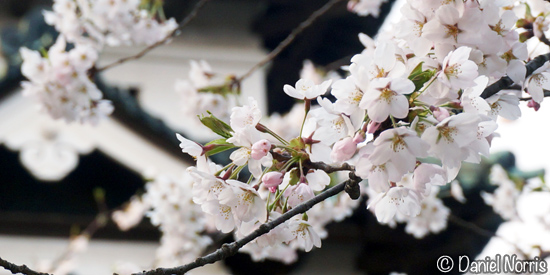 |
| Just outside the gate to Hirosaki Park |
Sakura (桜), or cherry blossoms, are the beautiful white and pink flowers that burst out from Japanese Cherry trees every Spring. The opening and subsequent mankai (満開), or full bloom, starts as the weather gets warmer. In most of Japan, this is from late March in the South to the middle of May in the north. The exception is Okinawa, where the bloom happens in January! Where I live in Aomori, and specifically in the neighboring town of Hirosaki, the peak of full bloom occurred on May 8th this year--very lucky for me.
On the previous day, I had just returned from my wonderful two-week vacation and I was sure that I had missed the short lifespan of the celebrated flowers while away based on prior sakura forecasts. But there I was, strolling around in Hirosaki Park on one of the best viewing days of the year, an hour before nightfall. It was just enough time to appreciate the light, airy presence of thousands of enchanting cherry trees before the sun retreated for the evening. Yet even at night, viewing cherry blossoms at Hirosaki Park is just as impressive. Against the backdrop of Hirosaki Castle, the radiant-white flowers seem to glow in the darkness.
On the previous day, I had just returned from my wonderful two-week vacation and I was sure that I had missed the short lifespan of the celebrated flowers while away based on prior sakura forecasts. But there I was, strolling around in Hirosaki Park on one of the best viewing days of the year, an hour before nightfall. It was just enough time to appreciate the light, airy presence of thousands of enchanting cherry trees before the sun retreated for the evening. Yet even at night, viewing cherry blossoms at Hirosaki Park is just as impressive. Against the backdrop of Hirosaki Castle, the radiant-white flowers seem to glow in the darkness.
 |
| Great nighttime view in Hirosaki Park |
Sakura is unquestionably one of the most significant elements of Japanese culture today. Every year, droves of Japanese families and friends make concerted efforts to enjoy the season by participating in hanami (花見), or cherry-blossom viewing. This traditionally involves picnicking under blooming cherry trees with lunch, sake (お酒, Japanese alcohol), and good company. Others simply walk around, snap photos, and enjoy the scenery. No matter how one decides to view the cherry blossoms, it's an incredibly worthwhile activity.
Visually, the flowers emanating en masse from the humble trees is a stunning sight to behold. Yet in Japanese culture, deeper meaning exists. From sprouting buds to stunning full bloom to inevitable death, cherry blossoms are thought to be a metaphor for the transience of life--which I essentially interpret as the notion that life is short and it will ultimately come to an end. This idea has been associated with the Japanese term, mono no aware (もののあはれ), which literally means, "the pathos of things." It's quite an interesting concept, in which an awareness of the ephemeral nature of all things will lead to a higher appreciation of their beauty. This seems quite simple but I can easily see how powerful such a perspective can be. It makes me wonder though, how well known these perspectives are to the younger generation in Japan. But at the very least, they can see imagery of sakura is everywhere in the country.
Whereas the opportunity to partake in cherry-blossom viewing is generally restricted to a mere two weeks every year, images, sounds, and tastes of sakura can be experienced daily in Japan. Cherry blossoms are a common motif found on kimonos (着物), the elegant traditional clothing Japanese people wear for ceremonies and other special affairs. It's very easy to find beautifully illustrated sakura in some of the oldest Japanese art as well as modern era pieces. Flip over any 100-yen coin, and you will see sakura. Go out for a night of karaoke and theres a good chance you'll hear songs about the lovely flower. Even KitKat has made a sakura-flavored version of their popular chocolate treats.
Visually, the flowers emanating en masse from the humble trees is a stunning sight to behold. Yet in Japanese culture, deeper meaning exists. From sprouting buds to stunning full bloom to inevitable death, cherry blossoms are thought to be a metaphor for the transience of life--which I essentially interpret as the notion that life is short and it will ultimately come to an end. This idea has been associated with the Japanese term, mono no aware (もののあはれ), which literally means, "the pathos of things." It's quite an interesting concept, in which an awareness of the ephemeral nature of all things will lead to a higher appreciation of their beauty. This seems quite simple but I can easily see how powerful such a perspective can be. It makes me wonder though, how well known these perspectives are to the younger generation in Japan. But at the very least, they can see imagery of sakura is everywhere in the country.
 |
| Hanami at Hirosaki Park |
